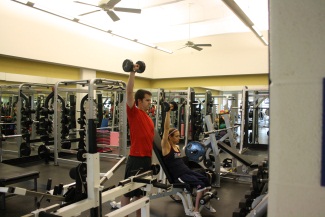 The next activity on my list tends to pose a bit more of a challenge. Lifting weights may be one of the hardest activities to do together. Not only do you probably not share the same goals, you also don’t have the same amount of function. Here are some things that I have found helpful. Start by turning your workouts into a circuit and have everything ready to go before the workout begins. That way you can hopefully limit the amount of times you have to transfer, and it’s also not quite as time consuming. When it’s time to do an exercise that one person isn’t able to do, try switching that exercise for them to target a small muscle group that they can use that the other able- bodied person might not concentrate on. Some examples might include internal/ external shoulder rotation, forearm extension, and shrugs.
The next activity on my list tends to pose a bit more of a challenge. Lifting weights may be one of the hardest activities to do together. Not only do you probably not share the same goals, you also don’t have the same amount of function. Here are some things that I have found helpful. Start by turning your workouts into a circuit and have everything ready to go before the workout begins. That way you can hopefully limit the amount of times you have to transfer, and it’s also not quite as time consuming. When it’s time to do an exercise that one person isn’t able to do, try switching that exercise for them to target a small muscle group that they can use that the other able- bodied person might not concentrate on. Some examples might include internal/ external shoulder rotation, forearm extension, and shrugs.

Another option is NCHPAD’s new Champion’s Rx, (www.nchpad.org/CRx), a high-intensity workout program designed for all ability levels. You can log in daily for a new workout and you and your significant other or spouse can do that workout together. Regardless of what workout program you choose, there are still lots of strength training exercises you can do together, such as all upper body exercises and some core exercises.
| Here is a sample 20-minute workout | |
| 40 seconds of work, 20 seconds to change | |
| Go through the circuit twice | |
| Able-Body Circuit | Adapted Circuit |
| Push-Ups | Push-Ups |
| Squats | Nordic Ski Arms |
| Rowing | Rowing |
| Lunges | Shrugs |
| Triceps Dips | Triceps Dips |
| Rope Pull | Rope Pull |
| Planks | Planks |
| Hang Cleans | Hang Cleans |
| Box Jumps | Push Motion |
| Roll Outs | Roll Outs |
